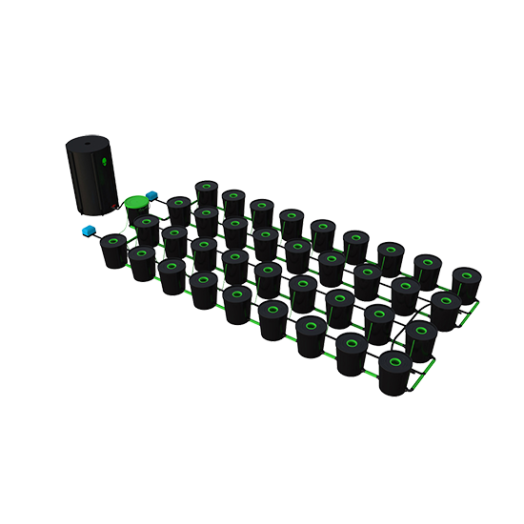RDWC Systems

DWC systems have individual buckets and plant roots grow from a handful of substrate into this highly oxygenated solution - In DWC, gardeners would have to check each bucket in order to see if the pH and EC values are within optimal limits which can be a time consuming task. RDWC systems use much the same technology as DWC systems with many of the benefits but all the pots in a system are linked to a central reservoir. The nutrient solution is circulated between pots and the reservoir, so the EC and pH should be more stable and consistent across all the plants in the system. For more info on RDWC systems and how to use them in your indoor garden, read our buyers guide below.
Recirculating Deep Water Culture (RDWC)
RDWC systems are a method of hydroponics in which plant roots sit in a bucket of nutrient rich, highly oxygenated water - providing the perfect environment for profuse growth. DWC methods use an air pump for each individual bucket and taking readings can be time consuming in larger set-ups. RDWC systems recirculate the nutrient solution across all the pots so it's suited for gardens with more plants as pH and EC will be consistent.
RDWC is a simple and effective hydro system that scales very well - anywhere from 4 to 32 pots can be implemented from one reservoir and you’ll only have to take a pH and EC measurement from one pot to get a representative reading of the entire system, without having to check each plant module individually. RDWC’s use a large volume of nutrient solution so there's less fluctuation when it comes to pH, EC and temperature because there's more solution to act as a buffer.
If your water temperature goes above 22 °C, your plants will be a lot more prone to contracting a disease such as pythium which could ruin an entire crop if left unchecked. You could use a peroxide containing product such as silver bullet roots or liquid oxygen to keep your system free from microorganisms. We recommend you to maintain a temperature between 18 - 20°C as this will facilitate the plants nutrient uptake, whilst effectively impeding the growth of bad microorganisms.
DWC and RDWC techniques require a very small amount of medium - only a handful of substrate is required for each pot which cuts down on the amount of waste your garden produces each cycle. If you use a substrate like clay balls you can wash them and remove any dead matter between cycles to ensure they’re clean enough to be reused. ‘Wicking’ substrates that can draw moisture through them due to capillary action should not be used in DWC or RDWC type systems as they can lead to a constantly wet root zone which could suffocate a plant - instead use a free-draining media like clay balls, growstones or seramis.
One of the issues with RDWC systems is the sheer number of moving parts that keep the system working - there are air pumps, nutrient pumps and pipework that could fail or clog, especially if you don’t clean your system between cycles. We recommend using a product such as drip-clean between cycles to keep all your gear in its best working condition. You could also keep a spare water pump and air pump on hand so in the event of a failure, down time will be minimised because you’ll just need to replace the failed component.
If you’re unsure which RDWC system is best suited for your plant requirements and space, email us or call our specialist team on 0800 085 7995 who can advise you on the best solution for your budget and experience level.


